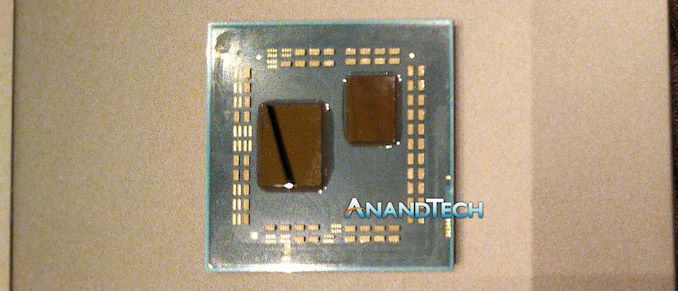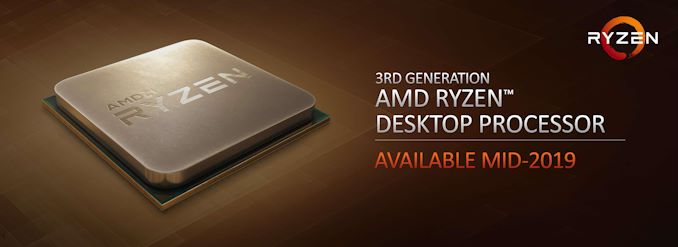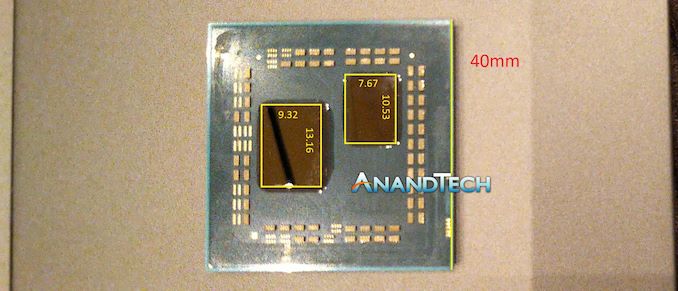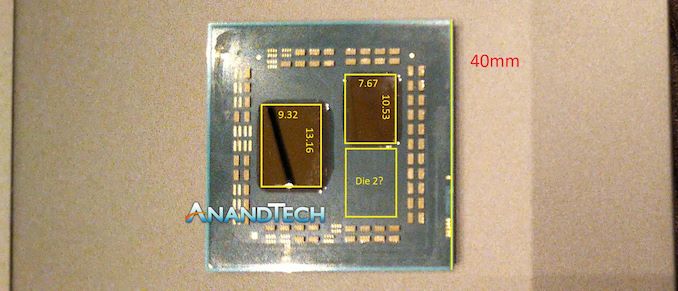AMD Ryzen 3rd Gen 'Matisse' Coming Mid 2019: Eight Core Zen 2 with PCIe 4.0 on Desktop
by Ian Cutress on January 9, 2019 1:01 PM EST
Blink and you miss it: AMD's keynote address this year was a whirlwind of primetime announcements for the company. The message is clear: AMD is committing itself to 7nm as the future process node that will drive the company's innovations starting in 2019. The first consumer products on 7nm will be the Ryzen 3rd Generation Desktop processors, using Zen 2 cores, offering more than competitive performance against Intel's best hardware. Also on the docket is a return to high-end graphics performance, with AMD set to release a 7nm graphics card that can spar blow-for-blow with the competition at the $700 price barrier.
AMD at CES 2019
One of the odd things about AMD’s announcements this show has been the tale of two halves. Normally a company will push out single major press release with everything in it. This year AMD discussed its news around Ryzen-3000 series mobile parts and AMD Chromebooks just as the show started, and we were all confused if this was going to constitute what was in the keynote or not – it would seem odd, after all, for the company to pre-announce its keynote announcements. Luckily, AMD has plenty to announce, and it’s all pretty juicy.
First up, CPUs. AMD presented its next generation 7nm desktop CPU, which is the 3rd Generation Ryzen.
Attacking the Mainstream CPU Market: Toe to Toe with Core i9-9900K
Ignore everything you might have heard about what AMD’s future desktop CPU is going to be. Here are most of the details you need to know.
The new parts, codenamed Matisse, will be coming to market in mid-2019 (sometime in Q2 or Q3). The processor the company had on display was made from two pieces of silicon on the package: one eight-core 7nm chiplet made at TSMC, and a 14nm input/output chiplet with the dual memory controllers and the PCIe lanes, made at GlobalFoundries.
The company did state that it is the world’s first 7nm gaming CPU, and will also be the world’s first mainstream CPU to support PCIe 4.0 x16. At this time the company is not commenting on if the 3rd Gen is going to have a maximum of eight cores, or if this represents the best processor of the whole family.
Because the processor is still far away from launch, frequencies are not being finalized yet. However, the processor is for the AM4 socket, given that AMD has previously said that it intends to keep backwards compatibility for several generations. That will mean that this CPU will work in current 300 and 400-series AMD motherboards.
What this means for PCIe 4.0 is actually fairly simple. We expect there to be a new line of motherboards presumably something like X570 that will be PCIe 4.0 compatible, for any new PCIe 4.0 graphics cards that will be coming to market. One of the differences with PCIe 4.0 is that it can only handle PCB traces up to 7 inches before needing a redriver/retimer, so these extra ICs are needed for ports lower down the board. But, the first PCIe slot on most motherboards is in that limit, so it would appear that a lot of current 300 and 400 series motherboards, assuming the traces adhere to signal integrity specifications, could have their first PCIe slot rated at PCIe 4.0 with new firmware.
Going For Die Size
As we can see on the die shot above, the 8-core chiplet is smaller than the IO-die, similar to the 8+1 chiplet design on EPYC. The IO-die is not exactly one quarter of the EPYC IO-die, as I predicted might be the case back the Rome server processor announcement launch, but it is actually somewhere between one quarter and one half.
Doing some measurements on our imagery of the processor, and knowing that an AM4 processor is 40mm square, we measure the chiplet to be 10.53 x 7.67 mm = 80.80 mm2, whereas the IO die is 13.16mm x 9.32 mm = 122.63 mm2.
+15% Performance Generation on Generation, Minimum.
During the keynote, AMD showed some performance numbers using the new Ryzen 3rd Generation (Matisse) processor. The test in question was Cinebench R15.
Our internal numbers show the 2nd Generation Ryzen 7 2700X scores 1754.
This new 3rd Generation Ryzen processor scored 2023.
This would mean that at current non-final clocks, the new parts give a 15.3% increase in performance generation on generation. Cinebench is an idealized situation for AMD, but this is not at final clocks either. It will depend on the workload, but this is an interesting data point to have.
Identical Performance to the Core i9-9900K, Minimum.
Our internal benchmarks show the 9900K with a score of 2032.
The 8-core AMD processor scored 2023, and the Intel Core i9-9900K scored 2042.
Both systems were running on strong air cooling, and we were told that the Core i9-9900K was allowed to run at its standard frequencies on an ASUS motherboard. The AMD chip, by contrast, was not running at final clocks. AMD said that both systems had identical power supplies, DRAM, SSDs, operating systems, patches, and both with a Vega 64 graphics card.
At Just Over Half The Power…?!
Also, in that same test, it showed the system level power. This includes the motherboard, DRAM, SSD, and so on. As the systems were supposedly identical, this makes the comparison CPU only. The Intel system, during Cinebench, ran at 180W. This result is in line with what we’ve seen on our systems, and sounds correct. The AMD system on the other hand was running at 130-132W.
If we take a look at our average system idle power in our own reviews which is around 55W, this would make the Intel CPU around 125W, whereas the AMD CPU would be around 75W.
| AMD Benchmarks at CES 2019 | ||||||
| AnandTech | System Power | Idle Power* | Chip Power | CB 15 MT Score (pre-brief) |
CB 15 MT Score (on-stage) |
All-Core Frequency |
| AMD Zen 2 | 130W | 55W | 75W | 2023 | 2057 | ? |
| Intel i9-9900K | 180W | 55W | 125W | 2042 | 2040 | 4.7 GHz |
| *A rough estimate given our previous review testing | ||||||
This suggests that AMD’s new processors with the same amount of cores are offering performance parity in select benchmarks to Intel’s highest performing mainstream processor, while consuming a lot less power. Almost half as much power.
That is a powerful statement. (ed: pun not intended)
How has AMD done this? IPC or Frequency?
We know a few things about the new Zen 2 microarchitecture. We know it has an improved branch predictor unit, and improved prefetcher, better micro-op cache management, a larger micro-op cache, increased dispatch bandwidth, increased retire bandwidth, native support for 256-bit floating point math, double size FMA units, and double size load-store units. These last three parts are key elements to an FP-heavy benchmark like Cinebench, and work a lot in AMD’s favor.
As the Intel CPU was allowed to run as standard, even on the ASUS board, it should reach around 4.7 GHz on an all-core turbo. AMD’s frequencies on the processor were unknown; but also they are not final and we ‘should expect more’. Well, if the processor was only running at 75W, and they can push it another 20-30W, then there’s going to be more frequency and more performance to be had.
The one thing we don’t know is how well TSMC’s 7nm performs with respect to voltage and frequency. The only chips that currently exist on the process are smartphone chips that are under 3 GHz. There is no comparable metric – one would assume that in order to be competitive with the Core i9-9900K, the processor would have to match the all-core frequency (4.7 GHz) if it was at the same IPC.
If the CPU can't match IPC or frequency, then three things are possible:
- If the TSMC process can’t go that high on frequency, then AMD is ahead of Intel on IPC, which is a massive change in the ranks of modern x86 hardware.
- If the TSMC process can clock above 5.0 GHz, AND there is room to spare in the power budget to go even higher, then it’s going to be really funny seeing these processors complete.
- AMD's Hyperthreading for software such as CineBench is out of this world.
TL;DR = AMD’s 3rd Gen Ryzen Processors Are Another Step Up
When speaking with AMD, their representative said that there will be more information to follow as we get closer to launch. They’re happy for users to discuss whether it is IPC or frequency that is making AMD the winner here, and they’ll disclose more closer to the time.
Ian, I Thought You Predicted Two Chiplets?
Naturally, I assumed that AMD would be presenting a Ryzen-3000 series desktop processor with sixteen cores. For me, and a lot of others, felt like a natural progression, but here we are today with AMD only mentioning an eight core chip.
My money on two chiplets and a quarter IO die
— Ian Cutress (@IanCutress) November 7, 2018
I predicted wrong, and I've lost my money (ed: in Las Vegas no less). But if we look at the processor, there’s still room for a surprise.
There’s room for a little something extra in there. There’s not much room for a little something extra, but I’m sure if AMD wanted to, there’s just enough space for another CPU chiplet (or a GPU chiplet) on this package. The question would then be around frequency and power, which are both valid.
There's also the question of lower core count processors and the cheaper end of the market. This processor uses silicon from TSMC, made in Taiwan, and GlobalFoundries, made in New York, then packaged together. We have heard some discussion from others not in the industry that this makes cheaper processors (sub $100) less feasible. It is entirely possible that AMD might address that market with future GPU.
What AMD has plans for in the future, I don’t know. I don’t have a crystal ball. But it does look like AMD has some room to grow in the future if they need to.













342 Comments
View All Comments
dgingeri - Thursday, January 10, 2019 - link
The manufacturing costs for Ryzen chips is less than $70. Even with this 2 chip package, it probably doesn't amount to more than $80. They can charge less and sell more and spread the engineering costs for the chip over a larger sales spread, and still capture market share. There are a lot of financial "experts" that just don't understand this aspect of business. They think in order to make more money they have to charge more. That's not true. If a business needs to recover $1 billion in engineering costs, they can do so more easily selling for a $200 markup across 5 million units more easily than charging a $2000 markup and expecting to sell 500,000 units. Plus, with the lower markup, it is more likely to sell additional units past the point of recovering costs for pure profit.FC switch and storage makers didn't understand this, and they lost market share and sales to an inferior technology: iSCSI. Now, businesses are buying iSCSI storage hand over fist because the ethernet switches cost so much less, even if it performs far less effectively than FC. In 2005, the cost of physically manufacturing a 48 port 8Gb switch was under $800, not including the engineering and development costs. They charged over $30,000 for one with only 16 ports enabled, and an additional $8000 to license 16 more ports, for a total of $46,000 for a 48 port switch. Manufacturing FC storage was actually less expensive than iSCSI storage because the standards were much more simple, but the FC storage sold for more because the only ones buying it were the ones who could afford the switches. If they'd charged only $4000 for those switches, they could easily have sold a hundred times as many and made more profit. In addition, that would have allowed businesses with lower budgets to buy FC storage, thus reducing the costs from the makers and increasing adoption. Instead, they kept the market restricted with high prices, and small businesses adopted iSCSI. Then iSCSI became the "budget" standard, and higher end businesses began adopting it for cost savings. Now, FC storage SANs are practically dead, despite the fact that 32Gb FC can outperform 100Gb iSCSI by over 30%. Many FC switch companies lost profits and ended up being gobbled up by other companies, and FC storage is pretty much gone. The FC switch makers priced themselves out of business.
AMD would probably make twice the profit selling their top end AM4 chip for $300 than they could at $400. That extra $100 would likely discourage half of their buyers at least, and end up reducing the profits they would make substantially. It is a delicate balance, and ones their financial experts likely have already calculated.
RSAUser - Friday, January 11, 2019 - link
+1 dgingeriArbie - Friday, January 11, 2019 - link
It's too bad none of the AMD management knows anything about the chip business or finances. If only they were as smart as you...hencok456 - Thursday, January 10, 2019 - link
Very nice post thanks for sharing. visit for any help related QuickBooks http://www.quickbooks-help.net/KOneJ - Thursday, January 10, 2019 - link
@ Ian Cutress: Just wanted you to know:"we were told that the Core i9-9900K was allowed to run at its standard frequencies on an ASUS motherboard."
Not what I saw in the press release footnotes @ https://globenewswire.com/news-release/2019/01/09/...
Footnote #9: "Testing performed AMD CES 2019 Keynote. In Cinebench R15 nT, the 3rd Gen AMD Ryzen Desktop engineering sample processor achieved a score of 2057, better than the Intel Core i9-9900K score of 2040. During testing, system wall power was measured at 134W for the AMD system and 191W for the Intel system; for a difference of (191-134)/191=.298 or 30% lower power consumption.
System configurations: AMD engineering sample silicon, Noctua NH-D15S thermal solution, AMD reference motherboard, 16GB (2x8) DDR4-2666 MHz memory, 512GB Samsung 850 PRO SSD, AMD Radeon RX Vega 64 GPU, graphics driver 18.30.19.01 (Adrenalin 18.9.3), Microsoft Windows 10 Pro (1809); Intel i909900K, Noctua NH-D15S thermal solution, Gigabyte Z390 Aorus, 16GB (2x8) DDR4-2666 MHz memory, 512GB Samsung 850 PRO SSD, AMD Radeon RX Vega 64 GPU, graphics driver 18.30.19.01 (Adrenalin 18.9.3), Microsoft Windows 10 Pro (1809)."
Yeah they made a typographical error with "i909900K" instead of i9 9900K or i9-9900K.
But they also specified "Gigabyte Z390 Aorus"
KOneJ - Thursday, January 10, 2019 - link
Anybody else notice that demo was run with DDR4-2666?LemmingOverlord - Thursday, January 10, 2019 - link
Gotta say: nothing Su presented yesterday was any bit surprising. So we got: higher clocks, tuned performance, lower consumption, lower manufacturing costs all-round. Yeah. The chiplet design is groundbreaking, but its benefits are part of a longer-term strategy (which is not exclusive to AMD, btw. Intel is going down the exact same route). The key to AMD's strategy right now is squarely pegged on the yields of 7nm output... much like Intel's on 14nm++, and that can be quite dangerous.Early Zen 2 silicon is showing tit-for-tat performance with Intel's Core i9 on the same number of cores. That's good. That's what we want. Same performance, a few less bucks.
On the GPU side, I was seriously underwhelmed by the shrunken Vega. Same thing, different node.
Is it just me or is AMD's current strategy just bitch-slapping Intel where Intel is throwing money at? (eSports)
Maxiking - Thursday, January 10, 2019 - link
We do not know anything about Zen 2 performance.2600x and 2700x are already faster in CineBench by cca 5% than 8700k, 9900k respectively clock to clock.
Hypothetical situation. Had it been no IPC gain, just improved frequency and power consumption, 2700x on 7nm or 2700x even on their 14nm+ would have been faster by 5% if matched clock to clock - i7 9900k boosts @ 4.7ghz for all cores.
KOneJ - Thursday, January 10, 2019 - link
You're not looking at the all-core difference between the 2600X, 2700X, 8700K, 9900K, not to mention cooling solutions, motherboard configurations, RAM speeds, timings, bandwidth, and channels, and how the all-core is sustained in Cinebench R15 under varying considerations. Also the feeding data structures with core acceptance off of uncore can be a bottleneck at high core OCs with diminishing scaling and reduced IPC. This is why cache overclocking exists, and the interactions are also dependent upon and nuanced with IF mesh, MoDeX, and the Ringbus of SKL K-SKU derivatives.KOneJ - Thursday, January 10, 2019 - link
At least Radeon Vega VII has 128 ROPs. Good news for Navi methinks.